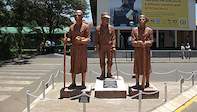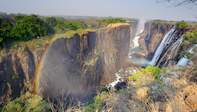
This historic city of Livingstone has become a hub for thrilling activities in the Victoria Falls area and is the capital of the Southern Province of Zambia.
The city can be accessed by scheduled air flights from Lusaka, Zambia and Johannesburg, South Africa and by a variety of road networks. There are also rail links to Livingstone from Lusaka.Once a very grand Edwardian town established in 1905, Livingstone is currently experiencing a revival with many exciting lodges, hotels and tour operators established in and around the town and along the Zambezi River. The Mosi-oa-Tunya National Park contains a variety of wildlife, including Elephant and Rhino, a rainforest, the Knife-edge Bridge, the Boiling Pot, 1st and 2nd gorge and various walks and viewing spots.Known as an adventure capital, Livingstone offers a thrilling array of sights and experiences showcasing top visitor attractions. The town is situated just 10km (6 miles) from the Zambian side of Victoria Falls. Visitors can travel on a tarred road from the town to the landmark bridge which spans the Zambezi River and gorge, connecting Zambia to Zimbabwe and the town of Victoria Falls.
The historic Victoria Falls Bridge was commissioned by Cecil John Rhodes, a turn of the century politician and entrepreneur, as part of his vision to link both countries by rail and road. The bridge was completed in 1905. From its vantage point, visitors can view the magnificent falls, feel the spray, and look down the gorge at the mighty Zambezi River. The bridge carries foot, road and rail traffic (with limits on heavy vehicles), and has a border post at each end.Early Press Wars in Africa
A little known fact about Livingstone is that it was the site of one of Africa's earliest press wars - at the turn of the 20th century. Two newspapers, for want of a better word (broadsheets pasted on the walls of pubs), were set up by "Mopane" Clarke's right-hand man, William Trayner.
The papers, known to the community as Trayner's Rag or The Livingstone Liar, were formalised in 1905 into a proper newspaper called The Livingstone Pioneer and Advertiser, which Victoria Falls trader Percy Clark described as "a very popular weekly with an enormous circulation sometimes as many as 50 copies a week net sales".
Competition came in the form of a rival weekly, The Livingstone Mail, started by Leopold Moore in 1906. It "entertained its readers with Moore's musings on the evolution of humanity, the future of the soul as well as other topics such as the current price of mealies". It pipped the Pioneer, selling 175 copies a week.
Moore survived such tropical obstacles as the wax on the duplicating stencils melting on the typewriter, and the Livingstone Mail survived for 60 years before closing down. Its commercial printing press, called the Livingstone Mail Printing Works, still operates today.
History of the Town of Livingstone

Livingstone owes its existence to two main factors - it was the main port of entry into the copperfields of what was then northwestern Rhodesia, and it was close to the Victoria Falls, which aided its development as a tourist town. Nonetheless, Livingstone's distance from the Falls - some 11km - puts it at a disadvantage to Victoria Falls town on the Zimbabwean side, where the Falls are within walking distance of the town centre.
Livingstone, which obviously takes its name from the explorer, was established in 1904 when the Old Drift settlement on the banks of the Zambezi was closed down because of malaria. Livingstone enjoyed an initial spurt of growth with the opening of the rail link across the Zambezi in 1905. Within two years, the new town had, according to historian DW Phillipson "two hotels, a restaurant, two mineral water factories, at least eight clothing and general stores, two butcheries, four building contractors and a chemist and a barber".
Indeed, Livingstone was the most important town in what was then Northern Rhodesia (an amalgamation of northeastern and northwestern Rhodesia) and was the capital of the territory between 1907 and 1935. Let it not be glossed over that the colonial administration of Livingstone in the first half of the 20th century was extremely racist, serving a settler community at the expense of the indigenous population, who suffered the degradations of second-class citizenship up until the 1950s.
Apartheid was alive and well in Northern Rhodesia with the first "location" for Africans established in 1907 where wood and iron shelters were built for "African men only" and rented out at a rate of one shilling per man per month.
Livingstone's influence was eroded by the economic growth of the copperbelt in northern Zambia, yet it remained a thriving tourist town until Zambian independence in 1964.
The socialist policies of the new Zambian government did not attract tourists, and Livingstone was dealt a further blow with Zimbabwean independence in 1980 and the consequent surge in tourism across the river. However, Livingstone underwent a revival in the late 1990s when the deteriorating political situation in Zimbabwe coincided with a period of renewed stability in Zambia after the first multi-party elections of 1991.
A 2001 study shows that Livingstone has 368 cultural heritage sites including archaeological sites, historical buildings, engineering structures and traditional sites, ten of which are national monuments. Guided historical walks of the Livingstone area are available from most of the Zambian-based tour operators.
The Usual Politics
Livingstone has been on the front line of two racial conflicts in Southern Africa - the nationalist challenge to the white minority governments of Rhodesia and South Africa during the second half of the 20th century. During the war against Ian Smith's UDI government, Joshua Nkomo's ZIPRA had a base near Livingstone. His troops were responsible for shooting down two commercial Air Rhodesia flights between Kariba and what was then Salisbury in the late 1970s.
The Rhodesian Special Forces drew up a plan to attack Nkomo's headquarters but never carried it out. Later, Livingstone was used as a transit point for African National Congress (ANC) guerillas fighting the National Party government in South Africa. In 1987, South African commandos attacked Livingstone in a pre-dawn helicopter raid and destroyed the National Provident Fund building, claiming that it was used to cache arms. Four Zambians died in the attack. The Zambian government and the ANC claimed that innocent civilians also died but the South African government claimed it as a victory against "terrorists".
The raid appeared to be carefully timed to bolster the apartheid government's support among the white electorate. When a negotiated settlement was reached between the white government and the liberation movements in the early 1990s, ANC exiles from Zambia formed the core of the first democratic South African government.
Things To Do in Livingstone

- Fly over the Victoria Falls - in a Microlight or helicopter for the best views
- Walk in the rainforest next to the falls - take a raincoat and lots of pictures
- Go on a game drive in Mosi-oa-Tunya National Park
- Explore great scenery on a Horse Trail - 2 hour excursions to combined campouts
- Golf and spa at the Livingstone Royal Golf and Country Club (18-hole par 72)
- Fish for Tiger Fish and Bream on the Zambezi River
- Enjoy daytime and sunset river cruises
- Shop for ethnic art and craft, fabric and more at colourful markets and craft shops
- Eat at a wide variety of top hotels, also pubs, restaurants, cafes and fast food outlets
More Things to Do in Livingstone and Vic Falls
Adventure Activities
- Bungi jumping from the Victoria Falls Bridge
- Abseiling, Gorge Swinging, High Wiring and Rap Jumping
- Intense White Water Rafting and River Boarding in the gorge
- Tandem Kayaking, Canoeing and Jet Boating
Learn more about the Extreme Victoria Falls Adventure Package and the Victoria Falls Adventure Pass
Interesting Sights
- The Livingstone Museum - Zambia's oldest and biggest
- The Railway Museum - a must for steam engine enthusiasts
- Sunset cruises on the Zambezi River
- Colonial architecture - a hotel and two churches in town are fine examples

 Livingstone, Zambia is a tourism centre for Victoria Falls, Mosi-oa-Tunya National Park and the Zambezi River. Known as an adventure capital...
Livingstone, Zambia is a tourism centre for Victoria Falls, Mosi-oa-Tunya National Park and the Zambezi River. Known as an adventure capital...